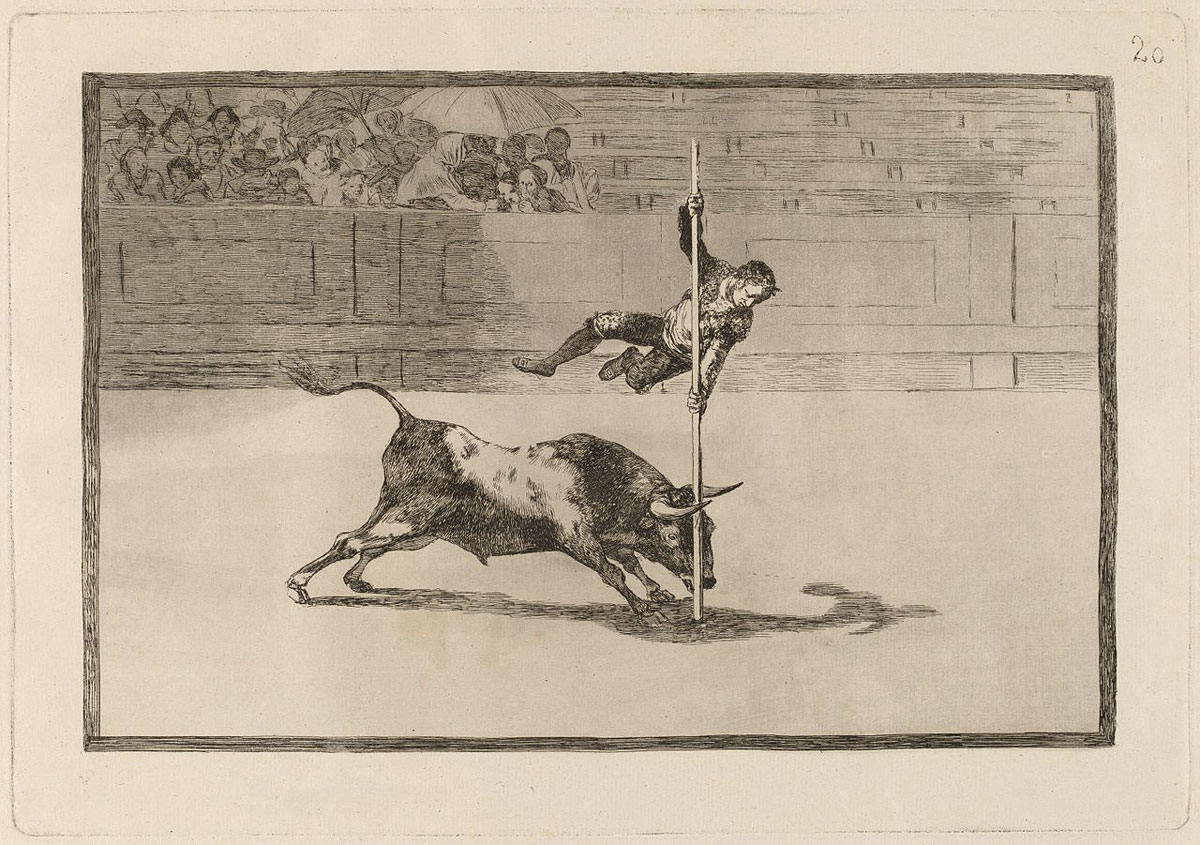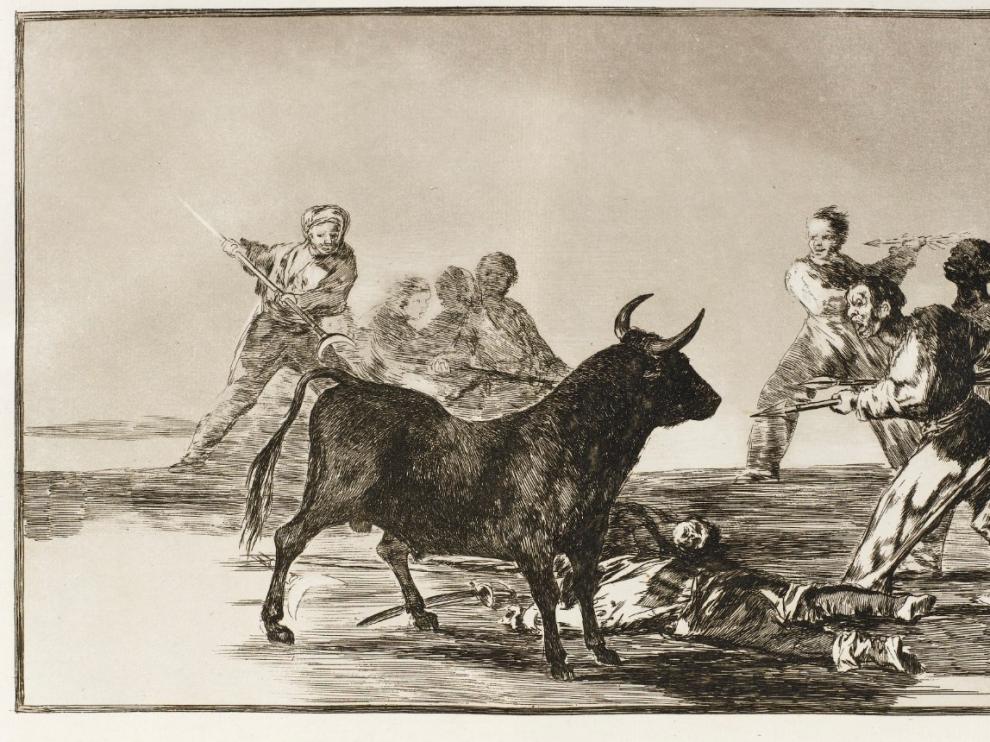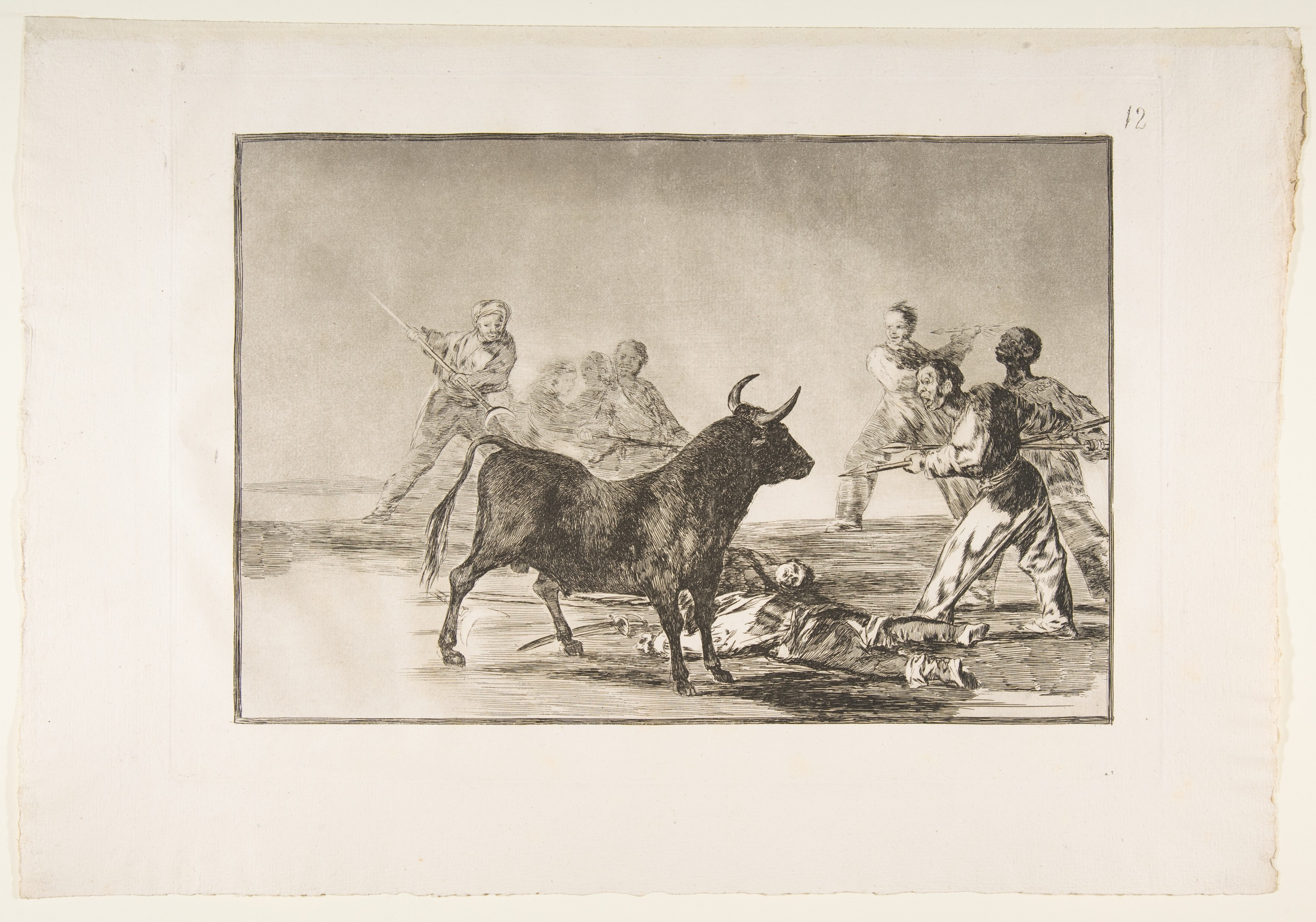
La Tauromaquia (1), 1929. Comprar obra de arte de Francisco de Goya Aguafuerte, Aguatinta
From Wikimedia Commons, the free media repository. English: This is a complete ordered gallery of the 33 plates in Francisco de Goya's La tauromaquia. Plates and English translations are from the National Gallery of Art. 1. Español: Modo con que los antiguos españoles cazaban los toros a caballo en el campo.

La Tauromaquia (32), 1929 Aguafuerte, Aguatinta, Bruñidor, Buril, Punta Seca de Francisco de
La Tauromaquia, a set of 33 prints etched by Francisco José de Goya y Lucientes in 1815 and 1816, illustrates the art of bullfighting from its medieval origins through to the artist's day. In the final plates in the series, Goya illustrated the awe-inspiring feats of his contemporaries, recording or imagining actual events in the bullring and paying homage to the most celebrated toreros of.
.jpg)
FileEl Cid Campeador lanceando otro toro (Tauromaquia Goya).jpg Wikimedia Commons
Plate 1 from "La Tauromaquia": The way in which the ancient Spaniards hunted bulls on horseback in the open country. Goya (Francisco de Goya y Lucientes). José Miguel Medrano El libro de la Tauromaquia. Francisco de Goya. Madrid, 2001. Mark McDonald Goya's Graphic Imagination. New York, 2021, (entry by Francisco J.R. Chaparro), cat. no. 66.

Libropasión EL ARTE DE LA TAUROMAQUIA DE GOYA
Tauromaquia. En 1816, Goya mit à la vente sa troisième grande série de gravures, "La Tauromachie". Dès sa jeunesse, Goya fut été un grand amateur des courses de taureaux. Après la guerre, les corridas et les spectacles de taureaux réapparurent avec force et Goya ne manqua pas l'occasion de gagner un peu d'argent mais la série.

40 grabados de Goya sobre el 'arte' de la tauromaquia
"La Tauromaquia (Francisco José de Goya y Lucientes) , G8590.-G8630," Harvard Art Museums collections online, Jan 05, 2024, https://hvrd.art/o/54984.. La Tauromaquia Other Titles Series/Book Title: La Tauromaquia Classification Prints Work Type book Date 1816 Culture Spanish

La Tauromaquia (18), 1929 Aguafuerte, Aguatinta, Bruñidor, Punta Seca de Francisco de Goya
Description. Francisco José de Goya y Lucientes. La Tauromaquia (Delteil 224-256; Harris 204-236) etchings and aquatint. The Tauromaquia sheets: approx. 314 by 445mm 12 3/8 by 17 3/4 in. album overall: 535 by 355 by 50 mm 21 by 13 7/8 by 2 in. The complete set of 33 etchings with burnished aquatint and lavis, drypoint and engraving, 1816.

La Tauromaquia (6), 1929 Aguafuerte, Aguatinta, Buril, Punta Seca de Francisco de Goya
In 1974, Pomona College acquired first-edition sets of three of Francisco Goya's four etching series: Los Caprichos (Caprices, 1799), Los Desastres de la Guerra (Disasters of War, 1810-14), and Los Disparates (Follies, also known as Los Proverbios or Proverbs, 1815-24). Twenty-five years later, the fourth has, at last, joined the collection.

El rinconcito de la historiadora COLECCIÓN DE LOS 33 GRABADOS DE LA TAUROMAQUIA DE GOYA.
Francisco Jose De Goya Lucientes. Art Funded. 1988. This first edition set of Goya's series of 33 prints on the subject of bullfighting deals with the origin and history of bullfighting in Spain, culminating with exploits of bullfighters famous during Goya's own lifetime. Although the sport is now widely regarded as cruel, Goya's images seem to.

Los grabados de La tauromaquia de Goya se expondrán en Madrid antes de ser subastados en Londres
La Tauromaquia (1816) is a suite of prints depicting the evolution and history of bullfighting on the Iberian Peninsula. Goya created La Tauromaquia between 1815 and 1816, at the age of 69.Los Caprichos, a series he had created previously, served as visual criticism on subjects concerning war, superstition, and contemporary Spanish society generally, including anticlerical scenes.

Francisco de Goya, La Tauromaquia (30), 1929 Comprar Arte, Aguafuerte, Aguatinta, Buril, Punta
In La Tauromaquia, created and assembled between 1814 and 1816, Goya focused his attention on the drama of the bullfight.The series begins with illustrations of the origins and history of bullfighting and ends with the extraordinary acrobatic feats of Martincho, famous for his daring stunts, one of which involved him vaulting from a table over a bull with his feet shackled.

Scoperto un set della Tauromaquia di Goya Artribune
Tomás Harris Goya: Engravings and Lithographs Vol. I: Text and Illustrations; Vol.II: Catalogue Raisonné. Oxford, 1964. José Manuel Matilla, José Miguel Medrano El libro de la Tauromaquia. Francisco de Goya. Madrid, 2001. Gary Tinterow, Geneviève Lacambre Manet/Velàzquez: The French Taste for Spanish Painting.

Los 33 grabados de Goya de 'La Tauromaquia', subastados por 600.000 euros Noticias de Ocio y
Tauromaquia. Goya sacó a la venta en 1816 su tercera gran serie de grabados, "La Tauromaquia". Goya había sido desde joven gran aficionado a la fiesta de los toros. Tras la guerra las corridas y espectáculos taurinos tuvieron un gran resurgimiento y Goya no desaprovechó la oportunidad para ganar algo de dinero, pero la serie no.

La Tauromaquia (24), 1929 Aguafuerte, Aguatinta, Bruñidor, Buril, Punta Seca de Francisco de
La Tauromaquia, or Bullfighting in English, is the title of a series of 33 etchings by Francisco de Goya which remain amongst his most important in this medium. The artist was in his late 60s at the time of working on this and was specialising in etching techniques during this period. Caprichos and The Disasters of War were other important.

The Power of Goya's 'La Tauromaquia' Prints Sotheby’s
La Tauromaquia ( Bullfighting) is a series of 33 prints created by the Spanish painter and printmaker Francisco Goya, which was published in 1816. The works of the series depict bullfighting scenes. There are also seven extra prints that were not published in the original edition.

Goya (Francisco de Goya y Lucientes) Plate 12 from "La Tauromaquia" The crowd hamstrings the
Goya devoted four Tauromaquia plates and one unpublished print to this otherwise obscure matador. Here, he sits on a chair with his feet shackled, confronting the charging animal. The matador's sword is echoed visually by the strip of burnished aquatint that follows a roughly horizontal path and demarcates two tonal sections.

FRANCISCO JOSÉ DE GOYA Y LUCIENTES LA TAUROMAQUIA (DELTEIL 224256; HARRIS 204236) Prints
Check Out Goya on eBay. Fill Your Cart With Color Today!